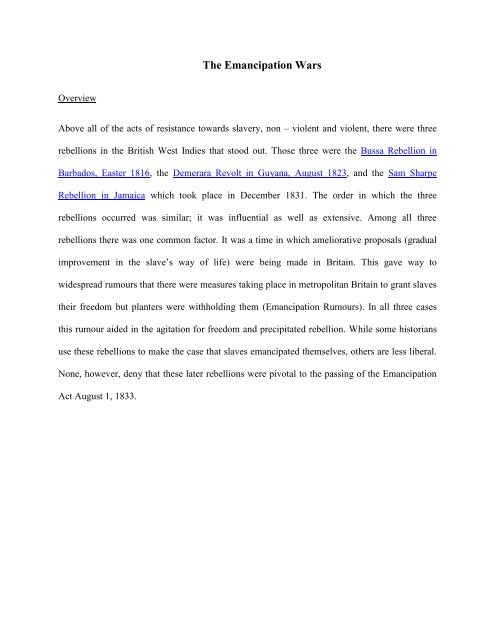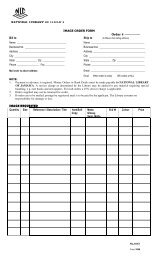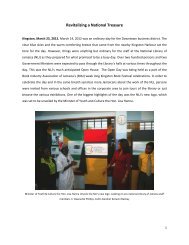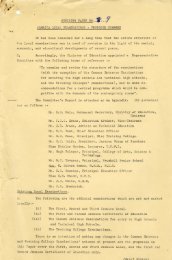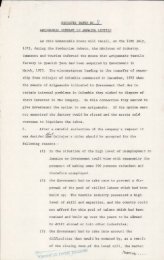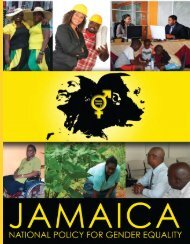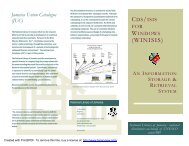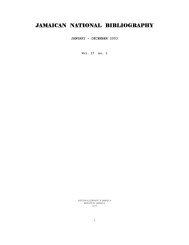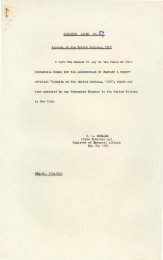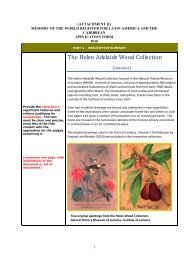The Emancipation Wars
The Emancipation Wars
The Emancipation Wars
Create successful ePaper yourself
Turn your PDF publications into a flip-book with our unique Google optimized e-Paper software.
<strong>The</strong> <strong>Emancipation</strong> <strong>Wars</strong><br />
Overview<br />
Above all of the acts of resistance towards slavery, non – violent and violent, there were three<br />
rebellions in the British West Indies that stood out. Those three were the Bussa Rebellion in<br />
Barbados, Easter 1816, the Demerara Revolt in Guyana, August 1823, and the Sam Sharpe<br />
Rebellion in Jamaica which took place in December 1831. <strong>The</strong> order in which the three<br />
rebellions occurred was similar; it was influential as well as extensive. Among all three<br />
rebellions there was one common factor. It was a time in which ameliorative proposals (gradual<br />
improvement in the slave’s way of life) were being made in Britain. This gave way to<br />
widespread rumours that there were measures taking place in metropolitan Britain to grant slaves<br />
their freedom but planters were withholding them (<strong>Emancipation</strong> Rumours). In all three cases<br />
this rumour aided in the agitation for freedom and precipitated rebellion. While some historians<br />
use these rebellions to make the case that slaves emancipated themselves, others are less liberal.<br />
None, however, deny that these later rebellions were pivotal to the passing of the <strong>Emancipation</strong><br />
Act August 1, 1833.
Bussa/Barbados Rebellion 1816<br />
Unexpected<br />
<strong>The</strong> Bussa rebellion of 1816 was not that expected as it is believed that slaves began to plan the<br />
rebellion soon after the House of Assembly discussed and rejected the imperial Registry Bill in<br />
November 1815 (Beckles 90). This Bill called for the registration of colonial slaves. As a result<br />
of this the rebels had discussed from February to rebel in April. <strong>The</strong> rebellion surprised the white<br />
community who believed slaves were well treated and enjoyed a level of freedom not had in<br />
other territories. One planter commented that he slept with his chamber open on that given night<br />
(Beckles 89).<br />
Organization & Leadership<br />
Each plantation actively involved in the insurrection had a leader. Two crucial plantations were<br />
Simmons Plantation, lead by John and Nanny Grigg and mostly importantly Jackey, as well as<br />
Bailey plantation, lead by King Wiltshire, Dick Bailey, Johnny and Bussa after whom the revolt<br />
was named.<br />
Jackey was a Creole slave head driver at Simmons Plantation in the parish of St Phillip. He was<br />
very instrumental in the build up to the rebellion as he coordinated meetings and discussions<br />
about revolting. Coercion played a part in getting some slaves to take part, as John who was<br />
Jackey’s assistant practiced this as he threatened that slaves’ houses would been burnt if they did<br />
not take part (Beckles 91).<br />
Bussa, after whom the rebellion is named, is seen as the key player and overall leader of the<br />
1816 rebellion. Bussa was an African driver at the Bailey Plantation at St. Phillip and to assume
the position he did, it is believed that he was respected by both slaves and planters alike. He was<br />
the only African in his position and it is said that 92% of the slave population was Creole. <strong>The</strong><br />
Times newspaper, Barbados, 1876, describes the rebellion as “<strong>The</strong> war of General Bussa”<br />
(Beckles and Shepherd 191). Bussa commanded a total of 400 enslaved men and women to fight<br />
against the whites. Historians Beckles and Shepherd, point to a possible military leadership style<br />
employed by Bussa (192).<br />
Further Planning & Organization<br />
In the planning and organization of the rebellion, slaves were not alone; a propaganda campaign<br />
was being done by three free coloured literate men; Cain Davis, Roach, and Richard Sarjeant.<br />
Each had a role to play in contributing to the rebellion. Davis, for instance, held meetings with<br />
slaves from several different plantations. He informed slaves of the emancipation rumours. This<br />
is important as this propagated the slaves’ desire to be free. Sarjeant played his part as well,<br />
employing the same tactics as Davis, as well as to mobilize slaves in the central parishes. <strong>The</strong><br />
final day of planning took place at the River plantation on Good Friday night April 12. It was<br />
disguised by the cover of a dance, and leaders such as Bussa, Jackey, and Davis were present.<br />
<strong>The</strong> Rebellion was to begin on Monday and from there the start of arsonist attack upon the white<br />
community, canes and buildings. <strong>The</strong> subsequent panic from the attacks would result on Tuesday<br />
or Wednesday, the murder of the white men across the island. That was not the case as the<br />
rebellion broke out earlier than originally planned believed to be the result of drunken slave<br />
relaying erroneous information to the rebels (Beckles 88).
<strong>The</strong> Rebellion<br />
<strong>The</strong> Rebellion started Easter Sunday Night April 14. It broke out with canes being burnt in St<br />
Phillip, signaling prematurely to rebels<br />
in central and southern parish that the<br />
rebellion had begun. Rebellion quickly<br />
spread from the parish of St. Phillip to<br />
neighbouring parishes where there<br />
were minor outbreaks of arson but no<br />
skirmishes with the militia. However<br />
in parishes such as St. Lucy and St.<br />
Peter there was no reported fighting.<br />
Up to seventy estates were affected,<br />
leaving whites fleeing to Bridgetown<br />
in considerable panic. <strong>The</strong>re has been<br />
debate on how many whites were<br />
Source: Testing the Chains<br />
actually killed during the rebellion but it is believed by historians to be one or two. <strong>The</strong>re was no<br />
great massacre done by the rebels, or damage to property, mostly plunder and burned canes. All<br />
in all, it is said that up to 25% of the years sugar crop was burnt and property damage was<br />
estimated at £175,000 which undermined the economic base of the planters (88).<br />
White’s Response/Punishment<br />
Colonel Codd, the commanding officer, acted promptly by imposing Marshall Law in the early<br />
hours of Monday April 15. Rebellion was short-lived as it was put down by the militia and the
imperial troops (slave soldiers) in three days and effectively over within a week. <strong>The</strong> Governor<br />
stated that one hundred and forty four (144) persons were executed by September under Marshall<br />
Law, seventy (70) were sentenced to death while one hundred and seventy (170) deported to<br />
neighbouring islands. Barbados’ topography made it quite easy to put the insurrection down as<br />
the land was mainly flat. Slaves who were captured in rebellion, through torturous methods<br />
ended up incriminating others which led to further captures. Marshall Law lasted eighty nine<br />
(89) days after it was imposed. Public punishments were done such as floggings and executions;<br />
which also served as notice to slaves of what they would receive if such action was ever<br />
replicated (Beckles 87).
Demerara Revolt 1823<br />
Demerara is a historical region in Guyana that experienced a Rebellion in 1823, which is<br />
regarded by some as more influential than that in Barbados 1816. In addition to outnumbering<br />
Source: Testing<br />
the Chains<br />
how many slaves were actively involved in revolt, it served as a very important part of history<br />
that shaped Guyana for many years to come.<br />
Reasons why they revolted<br />
Like every other colonial territory under slavery, slaves of Demerara were not accepting of living<br />
a life of servitude and sought to resist slavery in any way they could. Planters were divided over<br />
activities of missionaries but united in opposition to metropolitan interference. <strong>The</strong>y opposed<br />
angrily instructions sent by the Colonel Secretary, Lord Bathurst, in 1823 for ameliorating slave<br />
conditions. <strong>The</strong> attitudes that the planters displayed was a key contributing factor to the reasons<br />
for revolting added to their delayed implementation of ameliorative proposals. This perpetuated
the opinion among slaves that it was their freedom being withheld. Demerara revolt was mainly<br />
dominated by emancipation rumours, the driving force behind their call for freedom (Craton<br />
106).<br />
Planning & Organisation<br />
It was believed that there was no great deal of planning before the revolt. On the morning of<br />
Sunday August 17, 1823 at Plantation Success, slaves met together to discuss their plans. <strong>The</strong><br />
leaders of the Demerara revolt were believed to be Jack Gladstone who was a cooper on<br />
Plantation Success and his father Quamina who was a senior deacon at John Smith’s church.<br />
Gladstone and others planned the uprising but Quamina objected to any bloodshed and suggested<br />
that they should go on strike. Quamina went to see John Smith and two other slaves. He<br />
informed him of their plans to revolt but Smith had urged them not to revolt. Instead Smith<br />
encouraged them to exercise patience and wait until the new laws came out. He also asked<br />
Quamina to tell the other slaves especially the Christians not to rebel. Quamina obeyed and sent<br />
two of his companions to prevent them from rebelling. Quamina’s call apparently fell on deaf<br />
ears because despite his efforts they rebelled the following evening of Monday August 18. <strong>The</strong>ir<br />
plan was to seize all guns on the plantation, lock up the whites during the night and send them to<br />
the governor to bring the new law the next day (106). As is the case throughout most rebellions,<br />
there were slaves who were loyal to their masters. This resulted in a house slave names Joseph<br />
Packwood who told his master John Simpson about the planned revolt. Simpson told Governor<br />
Murray who rode up to Ressouvenir and met a large group of Africans on the road. <strong>The</strong>y<br />
demanded their rights and Governor Murray told them to go home which they refused to do.<br />
Shortly afterwards Marshall Law was imposed (106).
<strong>The</strong> Rebellion<br />
Initially, Demerara revolt involved no great violence. Some historians have noted that only a<br />
couple of whites were killed. Most slaves were Christians and for the most part non-violent but<br />
nevertheless got revenge on the whites that didn’t flee as they seized and locked up white<br />
managers and overseers on approximately thirty seven (37) plantations between Georgetown and<br />
East Demerara. By placing them in stocks this is where violence had erupted and it is reported<br />
that a few white men<br />
were killed. Christian<br />
slaves who didn’t want<br />
to lose their religious<br />
character refused to take<br />
part and stood loyal to<br />
their masters.<br />
plantation<br />
On a<br />
called<br />
Bachelor’s<br />
Adventure<br />
as many as 2000 slaves<br />
confronted Lieutenant Colonel John Leahy and his military. After much deliberation between<br />
slaves and Lieutenant Leahy, the slaves did not back down one even suggested to take them as<br />
hostage but Jack said no. <strong>The</strong> continued defiance from the slaves made Leahy order his troops to<br />
shoot. Some fled, some surrendered, but as many as 150-200 slaves were shot dead (106).
White’s Response/ Punishment<br />
On Tuesday August 19 th , the response and punishment that came after was severe. Real<br />
resistance by the slaves was over in two weeks mostly because of their poor organization. After<br />
Martial Law was declared, rebels were dispersed with great bloodshed. Hundreds of slaves were<br />
killed, many executed and Negro houses were fired. <strong>The</strong>re were fourteen (14) slaves who<br />
received death sentence but had it commuted and were sold or deported. Implicated slaves were<br />
sentenced to up to one thousand (1000) lashes, some sentenced to solitary confinement while<br />
others would be in chains for life. At Doch Four, 10-15 slaves were killed. At Good Hope six (6)<br />
slaves shot dead, while it was reportedly the same for Beehive plantation and Elizabeth Hall had<br />
forty (40) slaves killed (106).<br />
Jack Gladstone, Quamina’s son was believed to be<br />
deported to St. Lucia while Quamina who many<br />
considered as one of the leading characters of the<br />
rebellion was tracked down with the help of dogs and<br />
Indians and was shot and killed in Chateau Margot.<br />
Widely believed to be on September 20. Quamina<br />
was gibbeted at a roadside in front of Success estate.<br />
On August 25 Governor Murray set up a court<br />
martial for ring leader, those found guilty were shot<br />
or hanged. Heads were cut off and nailed to posts.<br />
An iron gibbet<br />
Over two hundred (200) slaves were beheaded and their heads placed on stakes at the parade<br />
grounds in Georgetown, Plaisance to Mahaica in east Demerara. Slaves who were not ring
leaders were given full pardon, provided that they surrendered within forty six (46) hours as<br />
stipulated by the governor (106).
Christmas/Sam Sharpe Rebellion<br />
In 1831, Jamaica experienced what was considered as one of the largest slave rebellions in the<br />
British Caribbean. <strong>The</strong> Sam Sharpe rebellion was described as the longest and most influential of<br />
the three emancipation era revolts. It was called the Christmas rebellion because of the time that<br />
the revolt took place which was shortly after Christmas.<br />
Like many plantation societies, the slaves far outnumbered their white counterparts and in<br />
Jamaica that figure was twelve to one (12-1), while the slave population was three thirds Creole.<br />
<strong>The</strong> Sam Sharpe Rebellion took on a religious aspect, much like that of the Demerara revolt.
Many slaves were Christians, mostly Baptists, hence, it is also called the Baptist War (Craton<br />
109).<br />
Leaders<br />
Samuel “Daddy” Sharpe rose to prominence and<br />
would assume leadership. Born in the Parish of St.<br />
James, he was a house slave and was widely<br />
believed to be named after his master. He was a<br />
Baptist deacon who was intelligent, literate,<br />
ambitious, and also displayed a talent for eloquence<br />
and was said to be an excellent orator (Craton 109). Other leaders included:<br />
Colonel Johnson who was a Slave Leader of Retrieve Estate successfully fought against the<br />
militia, commanded by Colonel Grignon on December 28 (Reckord 117).<br />
Captain Thomas Dove from Belvedere Plantation who like Sharpe was literate.<br />
Captain Robert Gardner, who was the head wagon man at Greenwich Plantation (Beckles and<br />
Shepherd 196).
Reasons why they revolted<br />
<strong>The</strong>re were various reasons why slaves of Jamaica revolted in 1831.<br />
Like Bussa’s revolt in 1816 and Demerara in 1823, there was also the emancipation<br />
rumour. Sharpe had said to slaves that their freedom was granted by the King but<br />
withheld by the masters.<br />
Rebellion was precipitated by political excitement stirred by economic stress, and a few<br />
whites that slaves could say were their allies.<br />
Events in England such as the Westminster debates also contributed.<br />
Slaves believed Thomas Burchell who was a Baptist missionary was bringing back “free<br />
paper” on a visit to England that he made. When he did not, they were angry and said<br />
they were deceived.<br />
<strong>The</strong>y strongly believed in the Bible, and held the notion that Sam Sharpe put forward that<br />
man should serve one master not two.<br />
Missions were a source of slaves’ philosophy; missionaries were seen as instrumental to<br />
the outbreak in planter’s eye and seen as dangerous.<br />
Planters cutting short their Christmas holiday.<br />
Planter’s attitude also pushed slaves to revolt. Historians note that planters were in protest<br />
to abolition of slavery. So much so, that they made inflammatory speeches and<br />
publications in newspapers. <strong>The</strong>se actions and attitudes contributed to the slaves’<br />
agitation and discontent (Reckord 108-125).
Planning & Organisation<br />
During this time, some slaves in leadership position like that of Sharpe were given limited<br />
freedom of movement and as such, they used that opportunity to meet undercover of traditional<br />
holiday celebration or religious service to discuss plans to revolt. At the end of prayer meeting a<br />
select few remained behind to hear and discuss the plans all the while swearing on the Bible to<br />
follow the plan. Sharpe insisted that after the Christmas holidays when harvest is due, slaves<br />
were to sit down and refuse to work until their masters acknowledged they were free and agreed<br />
to pay them wages (Reckord 113). In planning the revolt Sharpe used examples from Demerara<br />
and slave disturbances in America to encourage them to rebel. In the latter stages, Sharpe and his<br />
aides spread influence to Hanover, Westmoreland, Manchester, St. Elizabeth and Trelawney<br />
(c600 miles in all); persuading other slaves to join in the planned rebellion. On arrival from<br />
England missionaries were made aware of the plans to strike. <strong>The</strong> missionaries discouraged them<br />
and told them not to look to them for support. Shortly before the rebellion began on December<br />
27, William Knibb told them not to listen to the words of the wicked men and that they should<br />
not be led away. Blythe another missionary echoed the sentiments of his fellow missionaries and<br />
consequently they (slaves) were disappointed and even offended him. <strong>The</strong>y were furious and<br />
accused Blythe of deserting them and threatened to take revenge upon him (Reckord 116).
<strong>The</strong> Rebellion<br />
Slaves demanded more freedom and a working wage and promised not to return to work until<br />
their demands were met by the plantation owners. Upon refusal of their demands, the strike<br />
escalated into a full rebellion. On Monday December 27, 1831, rebellion broke out on the<br />
Kensington estate in Montego Bay. <strong>The</strong> outbreak was signaled by beacons made of the cane<br />
thrash houses. Whites not already in town for Christmas fled to Montego Bay, Falmouth, Lucea,<br />
Hanover, Black River<br />
and<br />
<strong>The</strong><br />
Savana-la-mar.<br />
militia<br />
commanded<br />
by<br />
Colonel Grignon beat<br />
a strategic retreat to<br />
Montego Bay after a<br />
skirmish at old<br />
Montpelier<br />
on<br />
December 28. Martial<br />
law was proclaimed<br />
by Governor Lord<br />
Belmore, and military commander Sir Willoughby Cotton acted promptly and efficiently with a 5<br />
pointed pincer campaign against the rebel fastness on upper Great River. <strong>The</strong> Christmas rebellion<br />
mainly comprised of armed rebellion, withdrawal of labour and most notably, destruction of<br />
property (Reckord 117). A rebel military core known as the Black Regiment lead by Colonel<br />
Johnson (Slave Leader) of Retrieve Estate successfully fought against the militia, commanded by
Colonel Grignon on December 28. <strong>The</strong> militia retreated to Montego Bay after a skirmish at old<br />
Montpelier on December 28.<br />
<strong>The</strong> Black Regiment further invaded hills, estates, inviting more slaves to join them, burning<br />
properties on the border on St. James and setting off a trail of fires through the Great River<br />
Valley in Westmoreland and St. Elizabeth. One hundred fifty slaves attacked the western interior<br />
regiment, the commander of that group waited until the slaves were within thirty five (35) yards<br />
then fired. Approximately twenty five slaves and one white were (25) killed and another four<br />
wounded (Craton 305).<br />
<strong>The</strong> Sam Sharpe Rebellion being the largest rebellion at that time to take place in Jamaica<br />
took longer than usual to suppress but when that moment finally came it was so done chiefly<br />
because of the lack of expertise in warfare and the lack of organization and cooperation among<br />
slave groups.<br />
White’s Response/ Punishment<br />
Even though it is said that the militia took control of the rebellion by the end of the first week in<br />
January, historians have noted that suppression took fully two months because of the slave’s<br />
guerilla tactics, and the country’s well suited terrain (Reckord 118). <strong>The</strong> Maroons assistance and<br />
cooperation was important as with their help the militia acted with excessive savagery against the<br />
slaves. <strong>The</strong> Maroons helped to track and hunt down rebels. In fact Maroons from Moore and<br />
Charles Town were shipped into Falmouth to further assist. Women and children were shot on<br />
sight and slave homes and provision grounds were systematically burned and there were<br />
numerous judicial murders by summary court martial (Beckles and Shepherd 199).
A number of slaves lost their lives, it is reported that 14 free coloured died in rebellion, 200<br />
slaves died in fighting, 312 executed and 300 flogged. Some rebel leaders were killed in<br />
fighting, captured or surrendered.<br />
A slave being whipped<br />
Pardon was offered by Sir Willoughby Cotton for all who returned to work on the estates within<br />
48 hours. He also released one hundred (100) rebel prisoners to circulate this news on the estate.<br />
Militia men presided over court martial’s; in St. James, ninety nine (99) slaves were tried, eighty<br />
one (81) were executed. (Reckord 120-121). It is believed that Samuel Sharpe was among the<br />
last set of persons last to be executed, He however spent a while in jail before he was hanged,<br />
and while in jail Reverend Henry Bleby visited him a few times. Bleby lamented that Sharpe<br />
regretted the extensive destruction of property and life from the conspiracy that he had promoted.<br />
It was not part of his original plan as he did not wish to destroy the estates nor anybody injured,<br />
as the only objective was to obtain freedom. Samuel Sharpe was hanged at Montego Bay on May
23, 1832. Before being hanged his last words were “I would rather die upon Yonder Gallows<br />
than to live in Slavery” (Craton 321)<br />
In all, six hundred and twenty-six (626) were tried and three hundred and twelve (312) executed.<br />
Executions mainly took place in the form of hanging as 72% were hanged while 28% were shot.<br />
In St. James, slaves were gibbeted and erected in the public square in the centre of the town. <strong>The</strong><br />
bodies remained until a fresh batch came. Such public displays served to horrify slaves who took<br />
part and was the planters’ way of trying to drive fear in them. In Lucea, the condemned were put<br />
in carts, with their arms pinioned, ropes around their neck and white caps on their heads, they<br />
eventually met their death. 71 <strong>The</strong> Baptists were blamed more than any other church groups, as it<br />
is said that they had the most subordinate chapel and gave authority to black deacons. <strong>The</strong><br />
missionaries fled to Kingston while Burchell and Knibb fled to England. Subsequently, the<br />
militia burned the chapels (Reckord 124).<br />
Damage<br />
Apart from £175,000 on military operation, the total cost of the rebellion was approximately<br />
£1,154,589 which historians note would be about £50,000,000 today. <strong>The</strong> cost of the rebellion<br />
includes. Injury sustained, slaves setting fires to buildings, burning cane fields, robbery, plunder,<br />
loss of labour and slaves killed in rebellion or executed (Craton 312).<br />
In final analysis, it can be concluded that slavery in itself was an unjust and inhumane<br />
institution that was bound to ‘resistance’ from slaves. <strong>The</strong>y were not content with living a life of<br />
servitude, especially one that entailed brutal treatment and methods of dehumanization. It can be<br />
said that British planters themselves were to be blamed for the many insurrections which took<br />
place in the British West Indies as the way in which slaves were treated, only helped to make the
situation worse than it already was. <strong>The</strong> Sam Sharpe Rebellion was a very important rebellion. It<br />
served as the last major rebellion in the British Caribbean before emancipation was declared a<br />
few years after. It is believed that this insurrection was one of the key reasons why it was passed<br />
as it is often said that it sped up measures that were being taken place. It is for this reason why<br />
the importance of the Sam Sharpe rebellion cannot be understated as it can be said to serve as a<br />
catalyst for the freedom that we now enjoy today.
Table showing Slaves total number of slaves tried and executed<br />
Parish Total Tried Total Executed<br />
Hanover Courts Martial 58 27<br />
Hanover Civil Courts 82 60<br />
Trelawny Courts Martial 70 24<br />
St. James Courts Martial 99 81<br />
St. James Civil Courts 81 39<br />
Westmoreland Courts Martial 26 12<br />
Westmoreland Civil Court 52 20<br />
St. Elizabeth Courts Martial 73 14<br />
Portland Courts Martial 23 7<br />
Portland Civil Courts 5 5<br />
St. Thomas in the Vale Courts<br />
9 __<br />
Martial<br />
Manchester Courts Martial 15 13<br />
Manchester Civil Courts 16 7<br />
St. Thomas in the East Courts<br />
12 1<br />
Martial<br />
St. Thomas in the East Civil Courts 5 2<br />
Total 626 312<br />
(Source: Reckord, Mary. “<strong>The</strong> Jamaican Slave Rebellion of 1831” Past & Present. 108-<br />
125. (1968). No 40. Web. July 3 rd 2013.)
Proclamation by the Earl of Belmore promising pardon to all slaves who will surrender<br />
or return to which they belong, having rebelled thinking they were emancipated
Willoughby G. Cotton’s speech to the slaves
A plan of the parish of St. James together with a part of the parishes of Hanover, Westmoreland<br />
& St. Elizabeth, 1832. Areas underlined in red were those involved Christmas Rebellion.
Bibliography<br />
Beckles, Mcd. Hilary. “<strong>The</strong> Slave-Drivers War: Bussa and the 1816 Barbados Slave<br />
Rebellion.” Boletín de Estudios Latinoamericanos y del Caribe, No 39. (1985):85-110.<br />
Web. 14 th June. 2013.<br />
Beckles, Mcd., Hilary and Verene Shepherd. Liberties Lost: <strong>The</strong> Indigenous Caribbean and<br />
Slave Systems. United Kingdom: Cambridge University Press, 2004. Print<br />
Bush, Barbara. Slavery and Abolition: A Journal of Comparative Studies. London: Frank<br />
Cass &Co Ltd, 1984. Print.<br />
Craton, Michael. Testing the Chains: Resistance to Slavery in the British West Indies. London:<br />
Cornell University Press, 1982. Print.<br />
Craton, Michael. “Proto-Peasant Revolts <strong>The</strong> Late Slave Rebellions in the British West<br />
Indies 1816-1832.” Past and Present .85 (1979): 117. Web. June 10 th 2013.<br />
Reckord, Mary. “<strong>The</strong> Jamaican Slave Rebellion of 1831.” Past & Present. 108- 125. (1968). No<br />
40. Web. July 3 rd 2013


